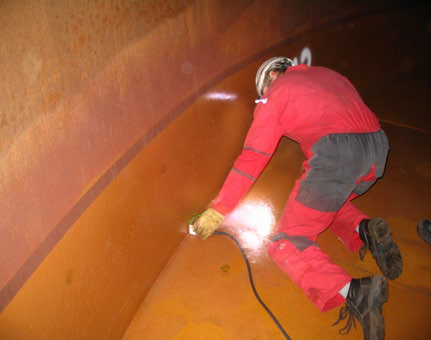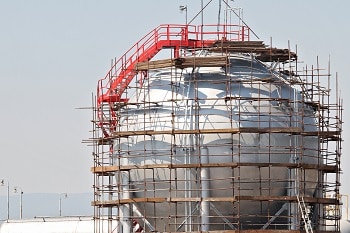Why Routine Tank Welding Inspection is Vital for Structural Honesty
Why Routine Tank Welding Inspection is Vital for Structural Honesty
Blog Article
A Detailed Summary of Storage Tank Welding Evaluation Specifications and Methodologies for Improved Weld Quality and Efficiency
The importance of welding assessment criteria in the manufacturing of tanks can not be overstated, as they serve as the backbone for making certain weld honesty and functional dependability. Various inspection techniques, consisting of visual evaluations and advanced non-destructive testing approaches, are important in determining prospective flaws that can endanger performance.
Importance of Welding Inspection Criteria

Welding inspection criteria include a series of requirements, consisting of material requirements, welding treatments, and qualifications of employees entailed in the welding procedure. By imposing these criteria, organizations can methodically determine and correct potential flaws, thereby reducing the chance of costly repair work or disastrous failures. Additionally, strenuous assessment practices promote a culture of responsibility and precision, motivating welders to maintain high levels of craftsmanship.

Common Welding Assessment Strategies


Ultrasonic Checking (UT) is another widespread method, using high-frequency acoustic waves to detect inner imperfections that might not show up on the surface. This approach is particularly effective for recognizing voids or additions within the weld steel. Magnetic Particle Testing (MT) is additionally widely utilized, especially for ferromagnetic products, as it discloses surface and near-surface flaws via the application of magnetic areas and ferrous fragments.
Additionally, Fluid Penetrant Screening (PT) detects surface-breaking issues by applying a penetrant to the weld and then making use of a designer to extract the penetrant. Each of these strategies adds to a comprehensive assessment approach, ensuring that welds meet the rigid quality standards needed in tank construction.
Regulative Specifications and Conformity
Regulatory requirements and compliance are essential components in ensuring the security and dependability of welded structures in container building - Tank Welding Inspection. These criteria serve to develop minimum requirements for product residential or commercial properties, welding treatments, and inspection techniques, therefore lowering the threat of architectural failings and boosting general efficiency
Key organizations, such as other the American Culture of Mechanical Engineers (ASME) and the American Welding Culture (AWS), provide guidelines that are commonly embraced in the industry. Conformity with these standards not only makes sure adherence to ideal practices however additionally meets legal and legal commitments, safeguarding the passions of stakeholders.
Regulative bodies typically mandate adherence to particular codes, such as ASME Code Section IX for welding credentials and API 650 for bonded tanks. These codes detail demands for welding strategies, credentials of personnel, and testing methods to verify weld integrity.
Regular audits and evaluations are vital to keeping conformity, as they aid determine deviations from developed requirements. Non-compliance can cause substantial fines, job hold-ups, and security hazards. Therefore, a robust understanding of governing criteria and a dedication to conformity are paramount in attaining high-quality and durable bonded storage tank structures.
Non-Destructive Testing Approaches
Just how can the honesty of bonded structures be Extra resources ensured without creating damages? Non-destructive testing (NDT) techniques supply a durable service, allowing assessors to review weld high quality without endangering the material - Tank Welding Inspection. Among one of the most typical NDT techniques are ultrasonic screening (UT), radiographic screening (RT), magnetic particle screening (MT), and color penetrant testing (PT)
Ultrasonic testing uses high-frequency sound waves to identify interior problems and characterize product buildings. It supplies exact dimensions and is particularly effective for thick materials. Radiographic testing involves passing X-rays or gamma rays with the weld, developing photos that reveal structural defects such as cracks or spaces. This technique is very useful for analyzing the honesty of complicated welds.
Magnetic fragment testing is matched for ferromagnetic products, where electromagnetic fields disclose surface and near-surface discontinuities. Dye penetrant screening makes use of a liquid dye to highlight surface-breaking imperfections, making it an effective technique for non-porous products.
Each of these NDT methods has unique benefits, permitting detailed analyses tailored to certain materials and welding processes. By carrying out these techniques, markets can make certain the reliability and security of welded structures, inevitably improving general efficiency.
Enhancing Weld Quality Through Assessment
Reliable evaluation plays a vital duty in enhancing weld high quality, offering as a crucial checkpoint in the manufacture procedure. By identifying prospective flaws early, inspections alleviate the threat of endangered architectural integrity and guarantee compliance with market requirements. Utilizing a combination of visual evaluations, non-destructive testing (NDT) methods, and mechanical assessments, inspectors can discover problems such as porosity, splits, and insufficient blend.
Implementing a robust assessment procedure not only enhances the general high quality of welds however likewise cultivates a society of liability amongst welders and producers. Routine training and accreditation of evaluation personnel make certain that they are geared up with the necessary abilities to acknowledge and deal with potential troubles properly. This proactive approach minimizes rework and linked expenses, eventually contributing to project effectiveness.
In addition, comprehensive documentation of inspection findings offers valuable understandings into here reoccuring problems, helping with continuous improvement in welding techniques. By leveraging sophisticated technologies, such as automated ultrasonic testing or electronic radiography, weld high quality can be boosted with much more accurate examinations. In final thought, an extensive evaluation process is crucial in achieving high-grade welds, making sure safety and security, dependability, and longevity in tank manufacture.
Verdict
In final thought, the implementation of extensive tank welding evaluation requirements and approaches is vital for guaranteeing weld integrity and performance. By using a mix of aesthetic assessments, non-destructive testing methods, and adherence to regulative standards, companies can successfully identify and minimize prospective defects.
Report this page